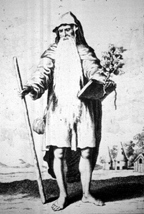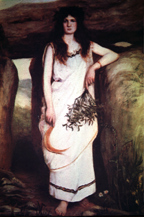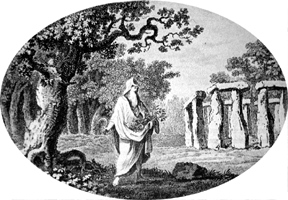|
| |
Click here go back to reading the paper
see also from the catholic encyclopedia
from britanica
Druids
wikipedia 2010
Alexander Cornelius Polyhistor referred to the Druids as
philosophers and called their doctrine of the immortality of the
soul and
reincarnation or
metempsychosis "Pythagorean":
- "The Pythagorean doctrine prevails among the Gauls'
teaching that the souls of men are immortal, and that after
a fixed number of years they will enter into another body."
"The principal point of their doctrine", says Caesar, "is
that the soul does not die and that after death it passes from
one body into another" (see
metempsychosis). Caesar wrote:
"With regard to their actual course of studies, the main
object of all education is, in their opinion, to imbue
their scholars with a firm belief in the
indestructibility of the human soul, which, according to
their belief, merely passes at death from one tenement
to another; for by such doctrine alone, they say, which
robs death of all its terrors, can the highest form of
human courage be developed. Subsidiary to the teachings
of this main principle, they hold various lectures and
discussions on
astronomy, on the extent and geographical
distribution of the globe, on the different branches of
natural philosophy, and on many problems connected with
religion".
óJulius Caesar, "De Bello Gallico", VI, 13
This led
Diodorus Siculus and others to the unlikely conclusion that
the druids may have been influenced by the teachings of
Pythagoras,[19]
One modern scholar has speculated that Buddhist missionaries had
been sent by the Indian king
Ashoka.[20]
Others have invoked
common Indo-European parallels.[
see also stone henge
Although since Christian times Druids have been
identified as wizards and soothsayers, in pre-Christian Celtic society they
formed an intellectual class comprising philosophers, judges, educators,
historians, doctors, seers, astronomers, and astrologers. The earliest surviving
Classical references to Druids date to the 2nd century B.C.E.
The word Druidae is of Celtic origin. The Roman writer Pliny the Elder
(Gaius Plinius Secundus, 23/24-79 C.E.) believed it to be a cognate with the
Greek work drus, meaning "an oak." Dru-wid combines the word roots
"oak" and "knowledge" (wid means "to know" or "to see" - as in the
Sanskrit vid). The oak (together with the rowan and hazel) was an
important sacred tree to the Druids. In the Celtic social system, Druid was a
title given to learned men and women possessing "oak knowledge" (or "oak
wisdom").
Some scholars have argued that Druids originally belonged to a pre-Celtic
('non-Aryan') population in Britain and Ireland (from where they spread to
Gaul), noting that there is no trace of Druidism among Celts elsewhere - in
Cisalpine Italy, Spain, or Galatia (modern Turkey). Others, however, believe
that Druids were an indigenous Celtic intelligentsia to be found among all
Celtic peoples, but were known by other names.
With the revival of interest in the Druids in later times, the question of
what they looked like has been largely a matter of imagination. Early
representations tended to show them dressed in vaguely classical garb. Aylett
Sammes, in his Britannia Antiqua Illustrata (1676), shows a Druid
barefoot dressed in a knee-length tunic and a hooded cloak. He holds a staff in
one hand and in the other a book and a sprig of mistletoe. A bag or scrip hangs
from his belt.

A fanciful image of a Druid
(Plate from Aylett Sammes, Britannia Antiqua Illustrata, 1676)
Sammes's drawing was subsequently copied
and modified by
William Stukeley who shortened his beard, removed the mistletoe, turned the
bag at his side into a sort of bottle or gourd, and placed an axe-head in his
belt.

Another fanciful image of a Druid
(Plate from William Stukeley, Stonehenge, a Temple Restored to the British
Druids, 1740)
Besides observing that the name 'Druid' is
derived from "oak", it was Pliny the Elder, in his Naturalis Historia
(XVI, 95), who associates the Druids with mistletoe and oak groves: "The
Druids...hold nothing more sacred than the mistletoe and the tree on which it
grows provided it is an oak. They choose the oak to form groves, and they do not
perform any religious rites without its foliage..." Pliny also describes how the
Druids used a "gold pruning hook" or "sickle" to gather the mistletoe.
"Anything growing on those trees [oaks] they regard as sent from heaven and
a sign that this tree has been chosen by the gods themselves. Mistletoe is,
however, very rarely found, and when found, it is gathered with great
ceremony and especially on the sixth day of the moon... They prepare a
ritual sacrifice and feast under the tree, and lead up two white bulls whose
horns are bound for the first time on this occasion. A priest attired in a
white vestment ascends the tree and with a golden pruning hook cuts the
mistletoe which is caught in a white cloth. Then next they sacrifice the
victims praying that the gods will make their gifts propitious to those to
whom they have given it. They believe that if given in drink the mistletoe
will give fecundity to any barren animal, and that it is predominant against
all poisons."
A nineteenth-century painting shows a Druidess holding both the sickle and a
sprig of mistletoe. She is also standing next to a megalithic structure.

A Druidess, holding mistletoe and a sickle,
standing next to a dolmen
(painting by La Roche, late nineteenth century)
Druids and Stone Circles
It was
John Aubrey,
writing in the 17th century, who first thought it a "probability" that stone
circles, such as
Stonehenge,
"were Temples of the Druids" and called his text on stone circles the Templa
Druidum. This idea was picked up by
William
Stukeley, in the early 18th century, who subtitled his first book,
Stonehenge, published in 1740, "a Temple Restored to the British Druids, and his
second, on Avebury, published in 1743, "a Temple of the British Druids."
Although later, in the 19th century, Sir John Lubbock (1834-1913) dated
Stonehenge to a period much earlier than the time of the Druids (that is, to
about 2000 B.C.E., whereas the Druids don't appear in the historical record
until 1800 years later), nonetheless the view was maintained by a minority that
Druids were pre-Celtic inhabitants of Britain and that the religious beliefs and
practices for which Stonehenge was first built are ancestral to those of the
later Celtic Druids.

A Druid, holding a sickle and mistletoe, stands
in a grove of sacred oak trees with a Stonehenge-like 'temple' (18th century)
|



